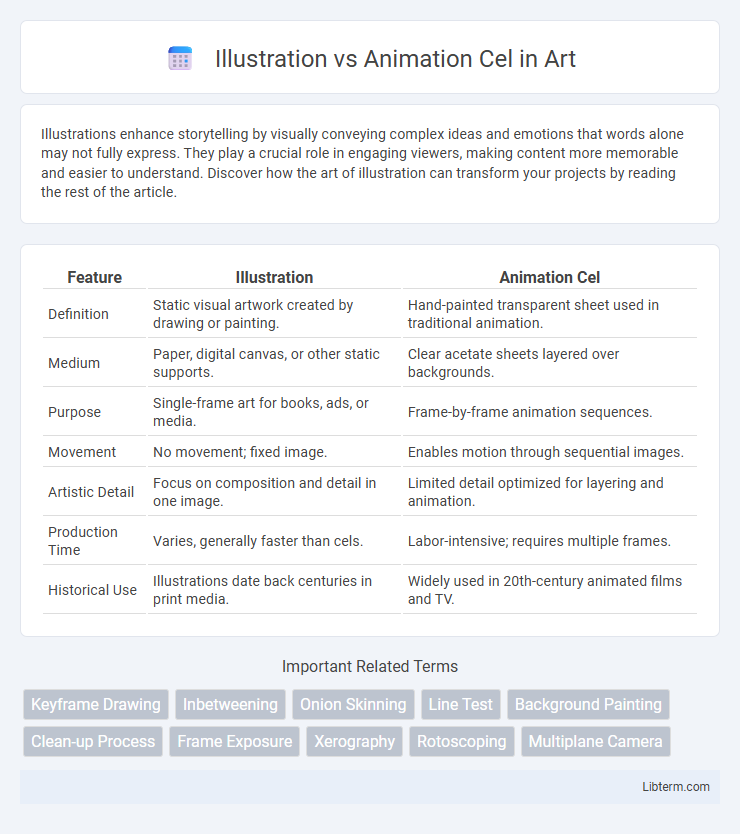Illustrations enhance storytelling by visually conveying complex ideas and emotions that words alone may not fully express. They play a crucial role in engaging viewers, making content more memorable and easier to understand. Discover how the art of illustration can transform your projects by reading the rest of the article.
Table of Comparison
| Feature | Illustration | Animation Cel |
|---|---|---|
| Definition | Static visual artwork created by drawing or painting. | Hand-painted transparent sheet used in traditional animation. |
| Medium | Paper, digital canvas, or other static supports. | Clear acetate sheets layered over backgrounds. |
| Purpose | Single-frame art for books, ads, or media. | Frame-by-frame animation sequences. |
| Movement | No movement; fixed image. | Enables motion through sequential images. |
| Artistic Detail | Focus on composition and detail in one image. | Limited detail optimized for layering and animation. |
| Production Time | Varies, generally faster than cels. | Labor-intensive; requires multiple frames. |
| Historical Use | Illustrations date back centuries in print media. | Widely used in 20th-century animated films and TV. |
Introduction to Illustration and Animation Cel
Illustration involves creating static visual representations using mediums like digital tools, pencils, or paints to convey concepts and stories through single images. Animation cels are transparent sheets where individual frames of a sequence are hand-painted or digitally drawn, enabling the illusion of movement when played in rapid succession. While illustrations capture a moment in time, animation cels are designed specifically for chronological visual storytelling in animated productions.
Definition of Illustration
Illustration refers to a static visual representation created to communicate or clarify concepts, often used in books, magazines, and advertising. It typically involves drawing, painting, or digital art to depict a single moment or idea with artistic expression and detail. Unlike animation cels, illustrations are standalone images, not frames intended for sequential movement.
What is an Animation Cel?
An animation cel is a transparent sheet on which characters and objects are hand-painted or printed for use in traditional animation, allowing individual frames to be layered over static backgrounds. These cels enable animators to create the illusion of movement by photographing a sequence of slightly altered drawings. Unlike illustrations, which are static artworks, animation cels are functional tools designed specifically for frame-by-frame production in animated films and television shows.
Historical Background of Illustration and Animation Cels
Illustration cels originated as hand-painted artworks created to design characters and scenes for early animation production, dating back to the early 20th century. Animation cels, developed shortly after, served as transparent layers that allowed animators to create movement by painting characters on sheets of celluloid and photographing them frame by frame. This process revolutionized animation by enabling efficient reuse of backgrounds and dynamic character motion, laying the foundation for classic animated films from studios like Disney and Warner Bros.
Key Differences Between Illustration and Animation Cel
Illustration is a single, static image created to convey a concept or story, often detailed and used in books, advertisements, or standalone art. Animation cel refers to a transparent sheet on which individual frames of animated characters or elements are hand-painted or printed, used sequentially to create motion in traditional animation. Key differences include the function, as illustrations capture a moment while animation cels enable fluid movement, and the medium, where animation cels require layering over backgrounds for frame-by-frame animation.
Techniques Used in Illustration vs Animation Cel
Illustration techniques primarily involve static image creation using methods such as digital painting, vector art, and traditional media like watercolor or ink to convey detailed visual storytelling. Animation cels, conversely, rely on frame-by-frame hand-painted or digitally rendered images on transparent sheets, emphasizing fluid motion through sequential art and timing controls. The key distinction lies in illustration's focus on standalone composition versus animation cel's integration into dynamic sequences requiring precise synchronization with movement and audio.
Popular Applications in Media and Entertainment
Illustration plays a critical role in media and entertainment by providing visually compelling static images used in branding, storyboarding, and concept art, with popular applications in graphic novels, advertising, and digital marketing campaigns. Animation cels, traditionally hand-painted transparent sheets, are foundational in classic animated films and TV shows, while digital animation techniques now dominate, featured in popular streaming series, video games, and cinematic productions. Both mediums contribute significantly to storytelling, with illustration grounding visual narratives and animation cels bringing motion and life to characters and scenes.
Advantages and Limitations of Each Medium
Illustration offers detailed, static visuals ideal for print and digital media, providing high resolution and precise control over composition, but lacks motion and dynamic storytelling capabilities. Animation cels enable fluid movement and sequential storytelling through frame-by-frame changes, enhancing viewer engagement, yet require extensive time and resources for production and are limited by traditional hand-drawn methods or complex digital processes. Both mediums complement each other, with illustration excelling in conceptual clarity and animation cels delivering dynamic, temporal narratives.
Collecting and Preserving Animation Cels and Illustrations
Collecting animation cels offers a tangible connection to classic film history, capturing hand-painted frames used in traditional animation, often valued for their rarity and authenticity. Illustrations, while also collectible, typically represent original artwork or production designs and may exist in various media, emphasizing artistic process over motion. Preservation of animation cels requires controlling light, humidity, and handling to prevent color fading and acetate degradation, whereas illustrations demand archival-grade storage to protect paper quality and pigment longevity.
The Future of Illustration and Animation Cel in Digital Art
The future of illustration and animation cel in digital art is shaped by advancements in software like Adobe Animate and Procreate, enabling artists to create more dynamic, detailed visuals with greater efficiency. While traditional animation cels are largely replaced by digital techniques, hybrid workflows combining hand-drawn elements and digital tools continue to push creative boundaries. Innovations in AI-driven animation and real-time rendering technologies promise to further revolutionize how illustrations and animation cels are produced and integrated into multimedia projects.
Illustration Infographic

 libterm.com
libterm.com